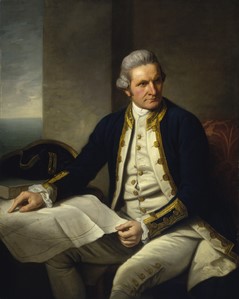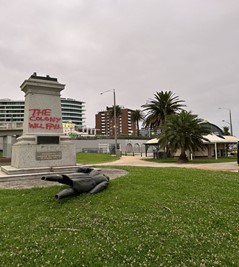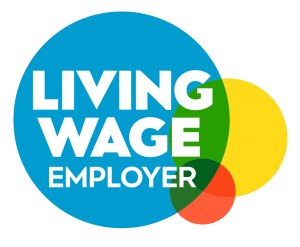North Yorkshire has a strong connection to British maritime history, with evidence of two thousand years of trade coming in and out of its harbours. Undoubtedly, one of the most famous figures embodying this connection is James Cook, born in the village of Marton-in-Cleveland in 1728. As a teenager, Cook was taken on as an apprentice in the merchant navy in Whitby, and soon volunteered to join the Royal Navy. Here, he worked his way through the ranks to eventually become the Captain Cook that we know him as today.[1]

Throughout North Yorkshire, there are collections of memorials dedicated to Cook, including (but not limited to) statues in Whitby, an obelisk in Great Ayton and even a hospital named after him in Middlesbrough.[2] There is no doubt that Cook is a figure many in North Yorkshire are proud to call a “home boy”. The stories of his rise from a poor farm labourer’s son to one of Britain’s most celebrated maritime explorers include themes for North Yorkshire to be proud of. However, there is also another side to this story which isn’t being discussed.
In 1768, HMS Endeavour set off from Plymouth under Cook’s command, bound for the South Pacific. The King officially patronised this voyage with the rationale that Cook and his crew would record the transit of Venus, but it was also a voyage of discovery for Britain, which was competing for land with other European nations.
This was the first of three voyages Cook took to the Pacific, and his detailed journals were published on his return to England.[3] On each of these voyages, a range of different communities and groups came into contact with Cook and his crew. Whilst a few of these encounters appear to have been amicable on the surface, many of them include incidents of violence, abuse and rape.[4]
Just one example of this is when the Endeavour first arrived in New Zealand, and during initial contact with the Maori people, a man named Te Maro was shot dead by one of Cook’s crew. Within the first few days, eight more Maori were shot and killed for stealing or refusing to cooperate with the European crew. In 2019, Britain officially expressed “regret” for these killings, but little else has changed in the relationship between Britain and Maori communities.[5]

These accounts of violence only grew more severe as Cook’s voyages continued. By his third and final voyage, many of the islands he visited had been ravished by diseases such as syphilis and leprosy, and each community had been ranked by its racial features and beauty. Ultimately, Cook’s voyages paved the way for European colonialism throughout the Pacific.[6] In Australia and the Pacific today, there are calls for change surrounding the perspectives we have on Cook.
Chris Healy and Andrea Witcomb explain how “in Australia and New Zealand, museums have been charged with the task of representing late twentieth and early twenty-first-century forms of nationhood and … contribute to the political process known as ‘reconciliation’”.[7]
During the 250th Anniversary of Cook’s arrival in the Pacific, protests were held in New Zealand and statues were vandalised in Auckland.[8] As recently as January 2024, on the eve of Australia Day, a statue of Cook in Melbourne’s Hyde Park was cut down, with the words “The Colony Will Fall” sprayed onto the monument.[9] Evidently, calls are being made in the southern hemisphere for an end to the hero-worshipping of Cook. In the UK, a different picture emerges. Despite a few articles being published on sites such as The Guardian in the past few years, a lot of the arguments around the two sides of Cook have been ignored.[10] This is particularly the case in North Yorkshire, which remains somewhat separated from the attempts to reimagine Cook that occasionally appear in London’s museums, and experiences very few calls for change.

What change that has occurred in North Yorkshire has often been met with backlash. In December 2023, it was announced on Facebook that the former Captain Cook Square in Middlesbrough would be now known as The Square. This was met with discontent from politicians and local community figures, including Alexander Downer, former Foreign Minister of Australia, who stated “Cook was a great navigator and explorer” and that “this is just another example of mad ideology which has poisoned the modern political left”.[11] The Facebook post was soon removed, and Middlesbrough council were quick to distance Labour mayor Chris Cooke from the proposed name change, while former mayor Andy Preston also claimed that any suggestion he had been involved in the decision was “absurd”.[12] Clearly, both sides of the UK political spectrum do not wish to speak out about these issues.
Additionally, at the beginning of this year, Middlesbrough Council proposed the closure of the Captain Cook Birthplace Museum due to budget cuts. There was a large outcry locally, including from the chairman of the Captain Cook Birthplace Trust who claimed that its closure would be a “tragedy”.[13] Whilst the closure of local museums is not the answer to reevaluating the way that North Yorkshire views Pacific histories, the lack of concern in the media and public sphere for what the museum stands for is apparent. Instead of taking the opportunity for discussion, criticisms have focused on the council and their budget cuts. In February, after public consultation, it was announced that the museum would reopen in April. Undoubtedly, much of this consultation mirrored the statement by the chairman, which claimed that Cook “is without doubt the greatest navigator the world has ever seen”.[14] Middlesbrough Council have since announced a study into the region’s heritage sector, which “aims to build a collective vision for the role that the sector plays in growing the visitor economy, as well as understanding the vital role of heritage sites and services in community life”.[15] Whilst the focus on supporting the local economy and community is much needed, again the opportunity to reflect on the representation of Cook and North Yorkshire’s connection to Pacific histories is being missed.
This leaves North Yorkshire in an interesting dilemma regarding its relationship with James Cook. Nonetheless, it appears that people are either unaware of the controversy surrounding Cook, or are too afraid to start conversations around the matter. In the meantime, an unquestioning narrative of Cook is being portrayed through celebratory representations of him on his travels. Irrespective of the sides people may take, these discussions need to start happening more. By bringing these debates into the media and public eye, we can educate more people on the controversies surrounding James Cook, and start to reevaluate the way that we perceive Pacific histories in North Yorkshire.
Written by Lucy Haddock-Williams
To learn more about the meeting point of local and imperial history in Yorkshire, you can join us on our next York Uncovered tour. You can also find out more about the Cook collections in Oxford’s Pitt Rivers Museum on one of our Curiosity & Colonialism tours, and why not check out this article from our archive exploring more Pacific legacies in the same museum?
References
[1] Richard Hough, Captain James Cook: a Biography (Hodder & Stoughton 1994).
[2] “Captain Cook Memorials Per Country”, Captain Cook Society, accessed 5 April 2024.
[3] W.J.L. Wharton, ed., Captain Cook’s Journal During His First Voyage Round the World Made in H.M. Bark “Endeavour” 1768-71 (Elliot Stock 1893), ch. 3.
[4] Margaret Jolly, “Women of the East, Women of the West: Region and Race, Gender and Sexuality on Cook’s Voyages” in Kate Fullagar, ed., The Atlantic World in the Antipodes: Effects and Transformations since the Eighteenth Century (Cambridge Scholars Publishing 2012).
[5] “Britain voices ‘regret’ for killing Maori 250 years ago”, Al Jazeera (2 October 2019).
[6] Nicholas Thomas, Islanders: The Pacific in the Age of Empire (Yale University Press 2010).
[7] Chris Healy and Andrea Witcomb, South Pacific Museums: Experiments in Culture (Clayton, Victoria, Australia: Monash University, 2006), p. 3.
[8] Eleanor Ainge Roy, “Vandalism forces New Zealand council to remove Captain Cook statue”, The Guardian (2 October 2018).
[9] Hannah Ritchie, “Captain Cook statue vandalised in Melbourne on eve of Australia Day”, BBC News (25 January 2024).
[10] Paul Daley, “Captain Cook’s legacy is complex, but whether white Australia likes it or not he is emblematic of violence and oppression”, The Guardian (3 October 2019).
[11] Phoebe Abruzzese, “Middlesbrough’s Captain Cook Birthplace Museum may close”, The Northern Echo (3 January 2024).
[12] Ibid.
[13] “Captain Cook museum closure would be a ‘tragedy‘”, BBC News (4 Jan 2024).
[14] Ibid.
[15] Naomi Corrigan, “£100k savings, visitors and funding: Next steps for under-threat Captain Cook Birthplace Museum”, Teeside Live (22 March 2024).





